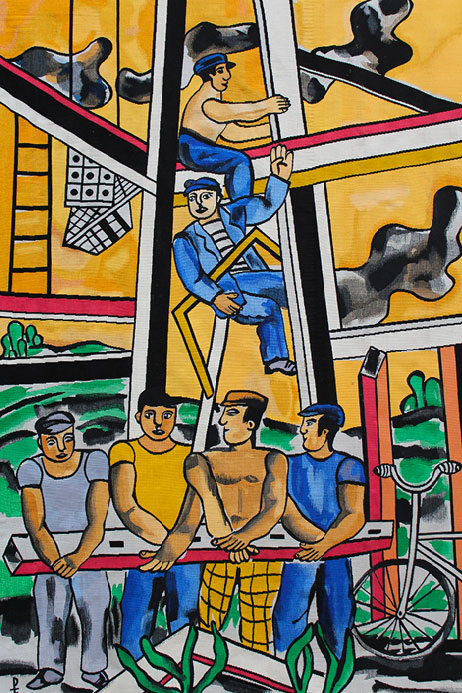
Les constructeurs jaunes
240×170 cm, edition N°1/6
tapestry after original drawing
by artist Fernand Léger
At PINTON, the word “know-how” is not brandished in vain or misused. Techniques are mastered, men and women are sensitive and passionate, particular attention is paid to the origin of materials as well as to the materials themselves, the transfer of skills and knowledge is valued – all contributing to the expertise of the firm.
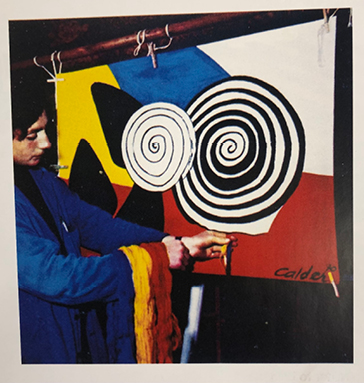
Jacques Bourdeix, cartoon painter and dyer,
and a tapestry by Alexandre Calder.
Cartoon painters and colours
Bent over his or her careful composition and giving it his or her full attention, the cartoon painter transposes the design created by the artist onto a cartoon to the dimensions of the tapestry, reversing left and right. Treading the line between art and craft, the cartoon is the translation of the painting into a future tapestry, like a pattern. It also serves to select the colours that will be used by the weaver: numbered and transferred to the cartoon, they are chosen by the cartoon painter who strives to remain as true as possible to the artwork. This makes up the rosary or chapelet, a sample of the different hues needed, gathered in small skeins knotted together. This work is essential to give all its impact to the tapestry. “To create a beautiful red, we blend different shades of red and we then have a colour that is moving, vibrant, alive”, explains Jacques Bourdei, cartoon painter at PINTON for over fifty years. Placed behind the warp threads and pinned in place, the cartoon guides the weaver in his or her work. The Maison PINTON archive contains over 4,000 original cartoons of rugs that can be reproduced on request.
“What I like most in my job is the research in colours and the transcription onto a cartoon. The transfer, or in other words, the “thread” interpretation of a painting or a photograph was the most significant aspect. I am truly happy to have had the opportunity to meet so many artists throughout my career.”

Picasso and his tapestry « Les Clowns », with Pierre Baudoin.
image © galerie Antonio Verolino
Maison PINTON – a master in the art of the aubusson tapestry
Aubusson tapestries: an age old tradition
Aubusson tapestries are produced on a horizontal low warp loom or métier de basse lisse. The weaver or lissier works the tapestry on the warp face, passing the weft threads through with a bobbin or flûte and covering the warp threads. Prior to that, the design to be woven was drawn by the artist and reproduced on a cartoon. The weaver, working closely with the artist and with the help of the cartoon painter, strives to select the best colours, materials and weaving variations to transpose the art faithfully. Using his or her precise and expert turn of hand, which has remained unchanged for nearly six centuries, the craftsperson puts his or her feelings and skill to the service of the artist working in symbiosis with the artwork. Emotion reaches a climax when the piece falls off the loom, which is known as tombée de métier, when at last they discover together the result of this careful and patient work: the whole tapestry, the right face up.
Aubusson rugs: techniques and materials
Intrinsically linked to the history of the Aubusson Tapestry, Aubusson rugs can be woven entirely by hand with using knotted stitches or points noués on a vertical high-warp loom or métier de haute lisse. They can also be woven on a low-warp loom, producing a flat weave rug or tapis ras because, unlike a knotted rug, there are no knots to create pile. Finally, Aubusson rugs can be tufted. This technique is more recent: the canvas is stretched over the frame and the pattern is transferred by hand. Threads are inserted manually, one by one, using a gun on the back of the canvas. These various processes require expertise, mastered skills and a deep knowledge of materials. Making a rug may involve using rough materials, some more difficult to handle than others. It may also require setting inserts or combining materials…
Knowledge sharing to perpetuate the art of doing well
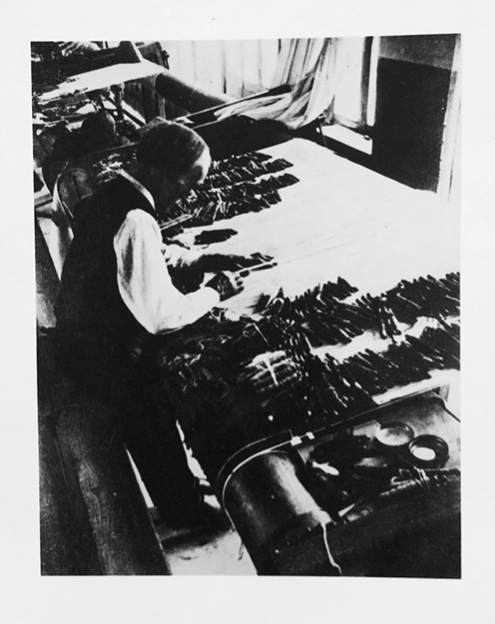
Since the creation of the business, our highly qualified craftspeople have been committed to sharing their knowledge. Maison PINTON encourages the transfer of skills and the awakening of vocations by organising visits of the manufactory and setting up partnerships with art students – some even come to train at PINTON. Other students are apprenticed following a career change. Acquiring the skills needed to create low-warp tapestries requires four years of training. Some of our previous apprentices have remained in our workshops and today are training the craftspeople of tomorrow!
Cartoon designer: an outstanding job
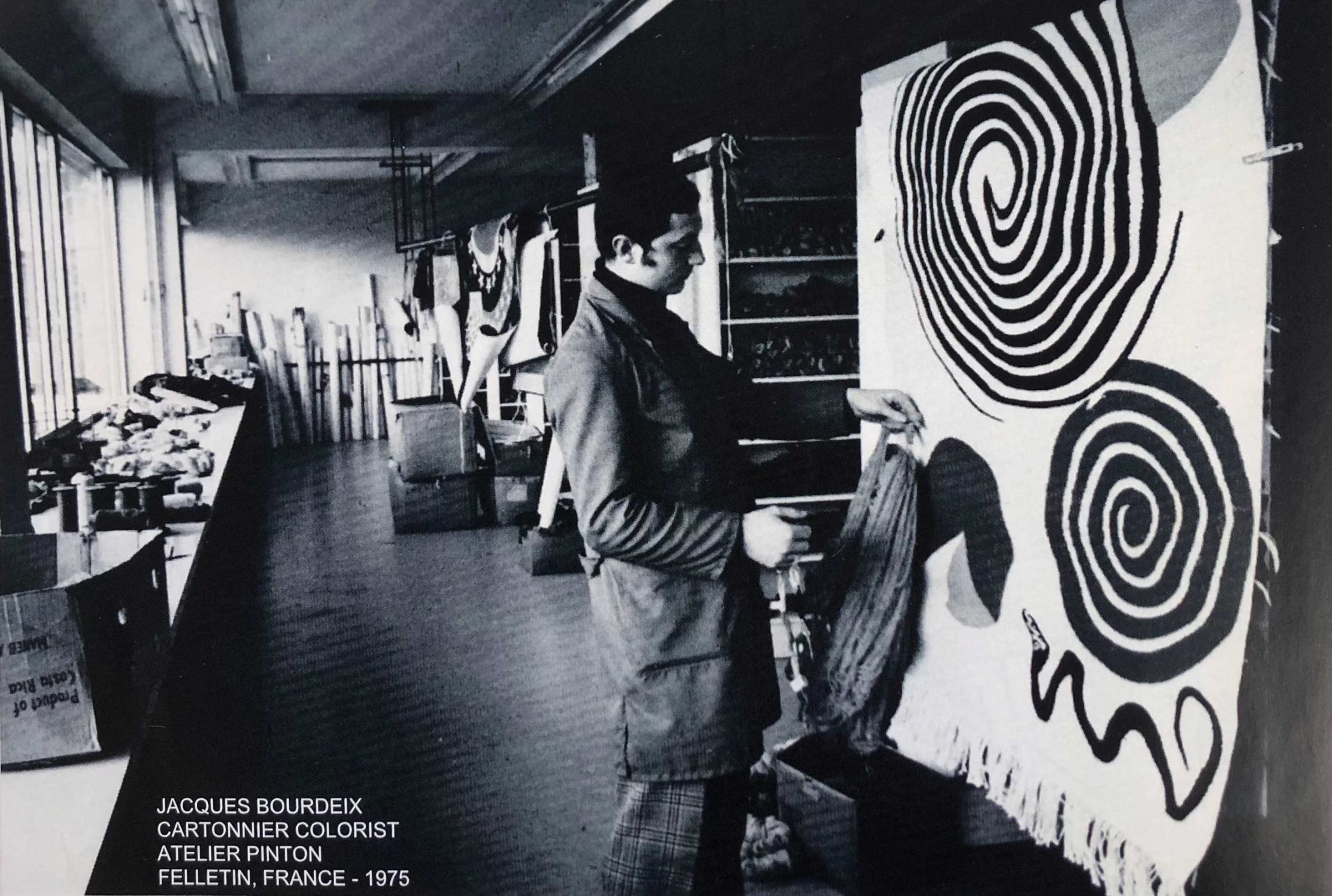
In the manufacturing process of a tapestry, the cartoon designer holds a pivotal role. His talent and know-how are essential in order to guarantee a successful interpretation of the drawing by the weavers. The provided tapestry cartoon connects the artist to the weavers and will be used as a pattern throughout the weaving. The cartoonist actually replicates the work of art created by the artist, and at the scale wanted for the tapestry. Furthermore, the work is replicated backwards because the cartoon is to be slipped beneath the warp threads of the loom. Some artists will design their own tapestry cartoons. For instance, in 1936, commissioned by collector Marie Cuttoli, Le Corbusier created his first tapestry cartoon for one of his pieces. Following that, he designed over thirty cartoons, many of which have been woven by PINTON.
At PINTON’s the craftsmanship for cartoon design is not taught but more passed on. Jacques Bourdeix, cartoon designer and colorist for PINTON since 1970, is one of the most prominent figures in the profession. In the year 2000 he received the title of Chevalier des Arts et des Lettres and shares his know-how and expertise gathered over years of collaboration with Alexander Calder, Etel Adnan, Fernando Botero and many others…
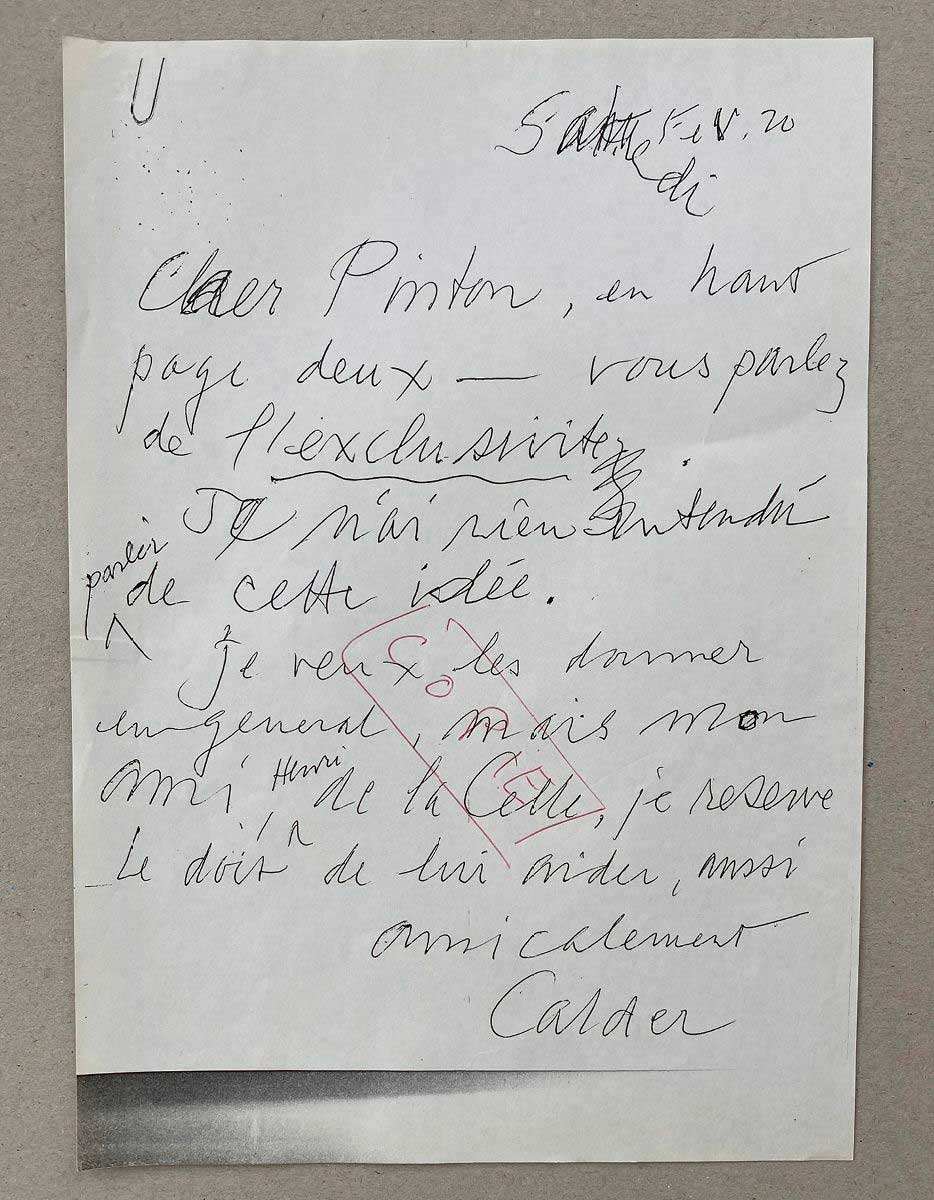
A letter from Calder to the Pinton Mill
image © archives PINTON
